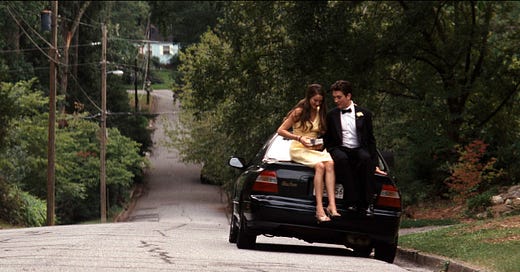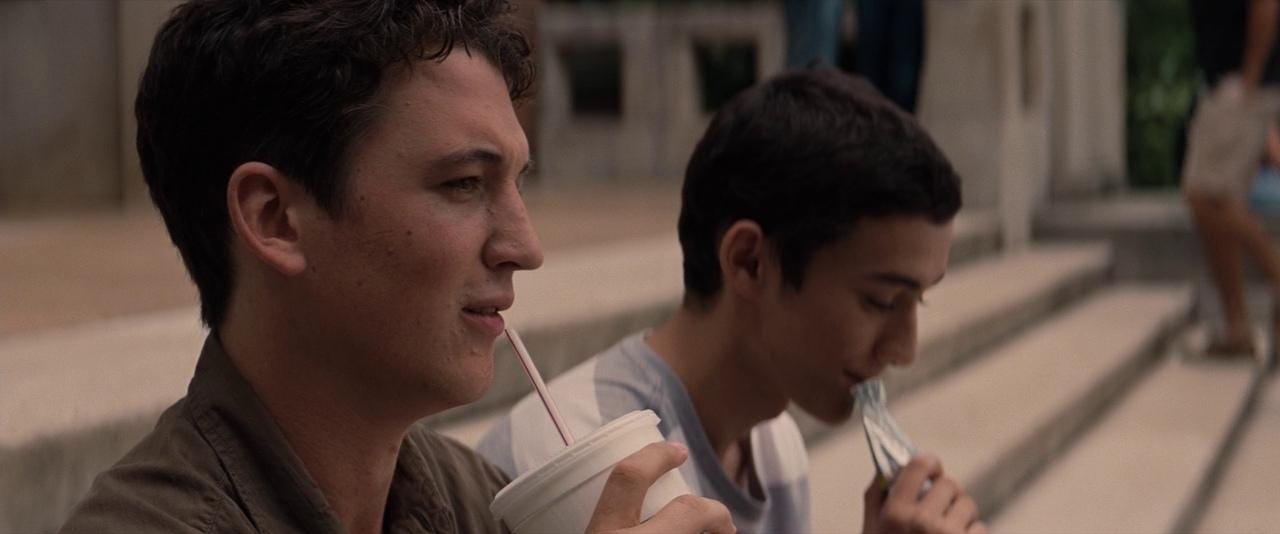One Perfect Scene: 'The Spectacular Now' (2013)
It's one thing to describe being drunk and in love. It's quite another to make the viewer feel it.
SPOILERS AHEAD.
Two seemingly contradictory things about the teenaged protagonist of director James Ponsoldt’s The Spectacular Now (2013) are simultaneously true: He’s reckless, kind of a fuck-up, and a danger to himself and others. At the same time, he is charming, affable, guileless.
Ponsoldt is careful to set up this dichotomy right away in the film’s clever, efficient prologue. In it, the young man, played by Miles Teller, is seen at his computer composing an application essay to some unnamed school’s dean of admissions. As he writes, we hear his words in voiceover. Rather than detail his academic merits or career ambitions, the boy, as if confiding in his diary, laments in remarkably informal prose his recent breakup with Cassidy (Brie Larson): “My name is Sutter Keely, and up until yesterday, I had the best fucking girlfriend in the world.”
Sutter next relates to the dean that a) for him, life is a party; and b) he and Cassidy were the life of it; and c) that she has grown weary of her role in the high school power-couple performance that has come to define the two of them.
This opening sequence also establishes that alcohol plays an outsize role in Sutter’s life. In the very first shot, he swigs from a bottle of PBR as he writes the essay. In the third, a flashback to he and Cassidy’s happier times, the pair are encircled by other teens who await their cue (Sutter’s toast) to drain their shot glasses. In the seventh, a fully-clothed Sutter, red plastic beer cup in hand, leaps into a swimming pool, and his fellow revelers follow suit.
Within the movie’s first 90 seconds, we thrice see Sutter (first at school, later behind the wheel) with his trusty, whisky-spiked Big Gulp. And though the film never establishes how the underaged boy acquires his booze, we see that he is by no means stingy with it. In the trunk of his car is a cooler of frosty beers, there as much to draw others to him as to ply himself.
We find in due time that Sutter does not merely enjoy alcohol; he reveres it, describes it in grandiose, quasi-religious terms. He says so himself — not aloud, but in the text of his essay, which one can read with a well-timed press of the pause button:
People talk about the “dangers” of alcohol, how harmful it is. Nobody talks about the good stuff. How much fun it can be. How good it feels. When I’m drinking, it’s like I can see another dimension to the world. Words and ideas I never knew I had come flying out of me. I’m funny, compassionate, in love with everything.
For this young man on the cusp of adulthood, booze takes him to the realm of the numinous, wherein everyone and everything is interconnected, suffused with the same warm glow. With evangelical zeal, Sutter passes his flask to all comers, an invitation to the higher plane he longs to permanently occupy.
But it’s one thing for Sutter to describe the swooning feeling that drink sparks in him. It’s quite another to somehow make us viewers feel it.
When Cassidy calls it quits with Sutter, he commences a proper bender, replete with crashing college bars, drunk driving, and “misplacing” his car. The next morning, he is awoken, confused, on the lawn of an unfamiliar home by Aimee (Shailene Woodley), a schoolmate he doesn’t recognize. But she knows him. Everyone knows Sutter Keely. Aimee happened upon the passed-out boy while running her morning newspaper route and stopped to ensure he wasn’t dead. Sutter, out of gratitude — and a desire to locate his missing Honda — offers to help her finish the task. They hit it off.
Following a school lunch date and a tutoring session, Sutter invites her to an afternoon keg party in the woods. He offers her a beer, but she declines. “I don’t really drink,” she says. Seconds later, Sutter spots Cassidy, who is joined by her new love interest, Marcus (Dayo Okeniyi). Rather than stick around and stew is his jealousy, Sutter proposes that he and Aimee take a walk.
Moments earlier, Aimee declined Sutter’s offer of a beer, but here she asks for a sip from his flask, the first of three she will take over the course of their saunter. Warmed by the bourbon, they both let their guards down. He volunteers that his penchant for booze stems from his father, no longer in his life, who permitted him sips of lager at baseball games when he was a young child. With similar vulnerability, Aimee tells Sutter that she has been accepted to a far-off college, one she ultimately will not attend because of her sense of obligation to her layabout mother. Sutter coaches Aimee to briefly abandon her prim disposition and shout, “Mom, get off my motherfucking back!” Apply that same energy to her controlling best friend or to an ex-boyfriend, Sutter says. But an ex assumes there are multiple exes from which to choose, when in fact there are none. How is that possible when she’s so beautiful, has asks. Aimee, ever modest, is embarrassed by his compliment and dismisses it; he responds by leaning in and delivering what is very likely her first kiss.
It’s a lovely scene, beautifully written and acted.1 But what sets it apart from the rest of the film, and most coming-of-age movies generally, is how Ponsoldt shoots it. Heretofore, The Spectacular Now was presented in more or less conventional, mainstream fashion. But as the two adolescents commence their stroll, the camera’s approach subtly shifts. From this point, the film does will not cut again for nearly four minutes.
Aimee and Sutter walk away from the other partygoers, who grow smaller and blurrier in the distance, and towards the camera, which moves backward with each of their steps. Indeed, the camera takes on a human quality. Rather than a perfectly smooth dolly or Steadicam shot, Ponsoldt shoots the scene handheld, without any mechanism to stabilize it. And as the camera operator moves over uneven terrain, their shot, and our viewpoint, slightly sways and bounces with each step, like a bobber on a fishing line. This isn’t the nauseating jerkiness of something like The Blair Witch Project (1999), mind you. Rather, it’s fluid, floating, lilting, as though the bourgeoning couple’s conversation were a melody, the camerawork its complimentary grace notes.
Throughout the movie, Sutter looks warmly at the world through besotted eyes — and here, so too does the camera. It regards the young couple as they, in this moment, regard one another: fuzzily, but with keen interest and genuine affection. And it’s not only the teens’ mounting intoxication that it reflects but also the palpable high of young love (the butterflies, that dreamlike feeling of weightlessness). In adolescence, everything is new and foreign and awkward and exhilarating — and all of that is captured and crystalized in these few minutes.
Take its final beat. As Sutter goes in for the kiss, so to does the camera, pushing in and tilting to observe the couple from a lower angle. It, and we, are closer to them now than at any other point in the scene. After a few seconds, he slowly pulls away, untethering their lips. Whatever he or she was planning to say next is never spoken, for a real-life fly intrudes into their moment and and darts straight into Sutter’s ear. He swats, they laugh, and the film cuts to black, thus ending this perfect scene.
If you appreciate the essays here at Material Ghosts, do me a solid and share it on your socials. Mmkay?
I am told that Woodley and Teller, who had worked together previously on the Divergent films, improvised portions of this scene. Their comfort with one another is apparent and lends a great deal of authenticity to their interactions.







A really lovely and unique film, and such a great essay too.
Fromtheyardtothearthouse.substack.com
Great analysis! I wish I could pick up on these subtle cinematography cues in real time.
I think this is the movie where I discovered Miles Teller. He’s a real talent.